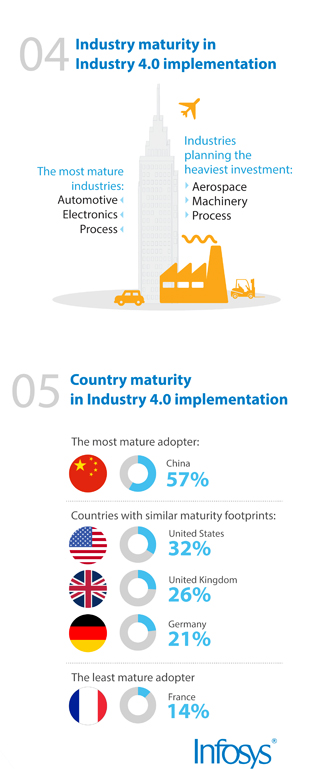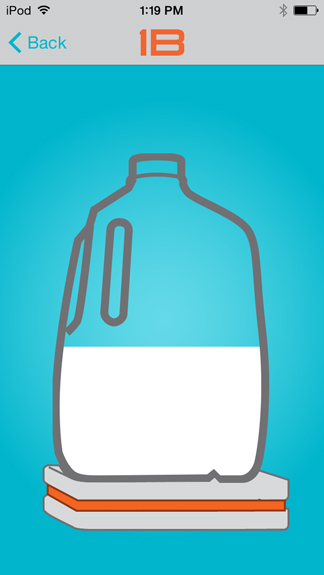
A snapshot of the state of IoT adoption, as depicted in an infographics by Infosys (image courtesy of Infosys).
May 14, 2015
 A snapshot of the state of IoT adoption, as depicted in an infographics by Infosys (image courtesy of Infosys).
A snapshot of the state of IoT adoption, as depicted in an infographics by Infosys (image courtesy of Infosys).On the third floor of San Francisco’s Moscone West conference center, charcoal and blue suits wondered the aisles of IoT World. One floor down, programmers and developers in beanies and skinny jeans flocked the entrance of Apps World North America. Inevitably, the two crowds crossed paths in the corridors, coffee stands, and nearby lunch spots. They traded glances as they stood next to one another to recharge their devices in the unoccupied wall outlets. The clash of the old and the new—established enterprises with deep pockets hoping to park their R&D dollars in high-yield IoT projects, and start-ups and new tech talents challenging the status quo with their Kickstarter- and Indiegogo-funded campaigns—is perhaps the most fascinating dichotomy in the Internet of Things (IoT).
A Call for Openness
The IoT keynotes and panel discussions took place on three different podiums: the Open Source Summit; Analytics Summit; and Ecosystem Center Stage. Adam Benzion, cofounder of Hackster.io, issued a blunt warning with his talk titled “Open Source Hardware is Eating the World.” (It wasn’t all gloom and doom; part of the talk was “Your Survival Guide.”) The benefits of an open hardware or software platform, Benzion pointed out, include: a larger community, third-party apps, and a thriving app marketplace. He advised, “Make it possible for others to engage with your device.” In other words, leave room for others to “hack” into your product—a notion that would make many manufacturers uncomfortable.
One big name manufacturer that has welcomed the hacker community is GE. Its demo station at the show features the ChillHub, a wired refrigerator complemented by smart apps. It’s a product of GE’s FirstBuild initiative, designed to foster collaboration between GE and the maker community. Through ChillHub’s USB and WiFi ports, tinkerers could access and interact with GE’s GreenBean module, the electrical brain of the appliance. The hardware runs on open-source Ubuntu software. Early apps available for ChillHub includes the Milkyway, an app that can remotely detect the volume of milk remaining.
What’s so smart about an app that remotely measures the weight of the milk carton, translates it into liquid volume, and sends alerts to you through the cloud? At the transactional level it may be no more than a feature of convenience, a simple exercise in connectivity. But programming logic that harnesses the accumulated data over time could lead to predictive and semi-autonomous operations. For example, if a particular household always replaces the milk carton when the volume gets down to 15%, ChillHub could be designed to place a milk delivery order from grocer Safeway’s online store when the app detects the level.
With connectivity comes also a security risk. Once connected, every appliance, tool, or product is accessible through its own IP address. IoT’s tantalizing potentials are inseparably linked the cloud; so too are its vulnerabilities.
 Milkyway app iPhone app, showing the volume of milk left in the ChillHub refrigerator (image courtesy of GE First Build).
Milkyway app iPhone app, showing the volume of milk left in the ChillHub refrigerator (image courtesy of GE First Build).Big Data Headache
Speaking to the audience from the IoT Analytics Summit, Peter Jensen, CEO of the data-analysis software provider ParStream, said, “There’s too much data to analyze, so some users collect the real-time data, but don’t get around to analyzing it.” When Bosch’s director of solution sales Robert Magnetti delivered his talk at the IoT Ecosystem Center Stage, he highlighted the same problem. He said, “I heard that 90% of the data gathered today isn’t used.”
Citing IBM, a ComputerWeekly article stated, “90% of data currently generated by connected devices, including smartphones, tablets, connected cars and appliances, is not analyzed or acted on, and most of it begins to lose its value within seconds of being generated” (”IBM sets up $3bn IoT unit to integrate unused data,” March 31, 2015). For example, the knowledge that the milk carton’s content has reached the 15% threshold is useful only for a time. A week after the initial detection, the data is no longer fresh enough for consumption (neither is the milk).
Bosch manufactures 2.5 million sensors a day, making it one of the largest sensor makers, according to Magnetti. The company also offers an IoT suite, with integrated data analysis functions. “Recognizing patterns and correlations within these huge masses of data [from sensors] and adapting services accordingly is an important prerequisite for successful IoT applications,” the company writes.
Magnetti said, “Event trigger management is one of the key pieces of IoT.” Such management requires considerable resources. He explained, “We have a data analysis division with roughly 200 people crunching data to get to the use cases that the customers want.”
.@HelmuthLudwig at the #IoTWorld2015 #RebuildSmart #Digitalization #Quote pic.twitter.com/JcTPjeGJ1r
— Siemens (@Siemens) May 13, 2015
From Products to Data, from Interface to Experience
IoT’s emphasis on real-time data, connectivity, and timely reaction changes traditional definition of “products.” The focus of product design now shifts from geometry to data. A connected product (like a self-driving car) is more than the vehicle itself. It’s an experience augmented by automation, real-time data, services, and apps.
IoT’s swift transformation of manufacturing puts pressure not only on the designers and engineers but also on those who supply tools to them. Some design software makers react to the demands of IoT through aggressive acquisitions. One example is PTC, which in the last few years transforms itself from a CAD and PLM software vendor to IoT product development firm. (For more, read “PTC Goes All In with IoT,” April 2015).
Subscribe to our FREE magazine, FREE email newsletters or both!
About the Author
Kenneth Wong is Digital Engineering’s resident blogger and senior editor. Email him at [email protected] or share your thoughts on this article at digitaleng.news/facebook.
Follow DE





